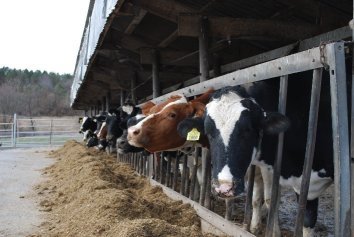Conservation Efforts on Farms Produce Multiple Benefits
Stories of Progress in Achieving Healthy Waters
U.S. EPA Region 3 Water Protection Division
Berks County, Pennsylvania • March 2019
A unique partnership has been instrumental in more than 30 projects that have improved drinking water, streams and farms in the Saucony Creek watershed in Pennsylvania’s Berks County.
The Schuylkill Action Network (SAN) partners have helped coordinate conservation effortson farms that have produced multiple benefits, including improved water quality in local streams, greater efficiency in farm operations and a steady drop in groundwater contaminants linked to agriculture resulting in cleaner drinking water.
The efforts and their results are documented in a 109-page 2017 reportfunded by the William Penn Foundation.
The Saucony Creek watershed is largely agricultural, populated by small family crop and livestock farms. The creek supports three community drinking water systems, including Kutztown, which serves over 14,000 people. The creek itself feeds into Lake Ontelaunee – the water supply for Reading. And from there it flows to the Schuylkill River and then the Delaware River, which are sources of drinking water for millions of people.
When farmers implement conservation practices that improve the operations of the farm, they also protect the ground and surface water sources of drinking water that flow through the property.
The practices installed have involved storing manure, controlling stormwater from barnyards, buffering streams with trees and vegetation, planting cover crops and using grazing regimes.
Saucony Creek farmers have reported that thanks to conservation practices, they have more efficient operations, healthier animals and improved soils.
EPA’s Mid-Atlantic Water Division has been closely involved in SAN activitiessince 2003 when EPA co-founded the SAN, a unique partnership of government agencies, non-profit groups and commercial interests focused on cleaning up pollution affecting the Schuylkill River.
The Division serves as a member of the SAN Agricultural Workgroup and advises on funding for specific projects. Activities are directed toward impaired streams, with priority to headwater areas.
Partners such as conservation districts receive EPA Clean Water Act Section 319 funds through the Pennsylvania Department of Environmental Protection to help in the restoration efforts.
U.S. Environmental Protection Agency
EPA Region 3 Water Division
Philadelphia, PA
-
Conservation Efforts on Farms Produce Multiple Benefits (pdf)
(416.82 KB, March 2019)
A unique partnership has been instrumental in more than 30 projects that have improved drinking water, streams and farms in the Saucony Creek watershed in Pennsylvania’s Berks County.

AT A GLANCE
- Conservation efforts promote clean water and healthy farms.
- Manure storage, stormwater control and streamside trees and vegetation are among the beneficial projects.
For additional information, contact:
Beth Garcia, garcia.beth@epa.gov
EPA Water Division
